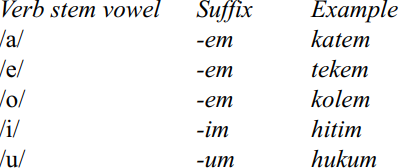
Transitive suffix -Vm: vowel harmony
 المؤلف:
Christine Jourdan and Rachel Selbach
المؤلف:
Christine Jourdan and Rachel Selbach
 المصدر:
A Handbook Of Varieties Of English Phonology
المصدر:
A Handbook Of Varieties Of English Phonology
 الجزء والصفحة:
706-39
الجزء والصفحة:
706-39
 2024-04-27
2024-04-27
 1309
1309
Transitive suffix -Vm: vowel harmony
As described on the morphology and syntax of Solomon Islands Pijin, Pijin transitive verbs are marked with a suffix -Vm, variously -em, -im or -um. As with insertion of paragogic vowels, the vowel in -Vm is selected with respect to rules of vowel harmony. The specific rules of harmony can again vary from one speaker to the next. One possible system is the one illustrated below, where roots containing mid and low vowels take -em as a suffix, but roots with high vowels will take the identical high vowel in the suffix,- im or -um.

Thus, while kat-, tek- and kol- become katem, tekem and kolem, /huk/ ‘to hook’ becomes /hukum/ ‘to hook something’ and /hit/ ‘to hit’ becomes /hitim/ ‘to hit someone’.
However, /baet/ ‘to bite’ becomes /baetim/ for some speakers and /baetem/ for others. Further, some streamlining common in the speech of young urban Pijin speakers may shorten the -Vm to /m/. Thus ansam ‘to give an answer’ instead of ansar-em, kalam ‘to colour something’ instead of kalar-em, etc.
There are more exceptions. While -em seems to function as the default suffix, - im appears more likely in neologisms such as fotokopim ‘to photocopy something’ and faksim ‘to fax something’. Nevertheless, it appears that -em is always a possible realization of the transitive suffix. In this respect again, /e/ is the underspecified vowel.
While the variation in the realization of the vowel in the transitivizing suffix is quite large, vowel harmony nevertheless determines the insertion of the vowel into the suffix whose vowel is underspecified for height or frontness. The quality of the vowels added to the stem is determined by the stem. This applies for epenthesis, paragogue and suffixation of the transitive marker.
 الاكثر قراءة في Phonology
الاكثر قراءة في Phonology
 اخر الاخبار
اخر الاخبار
اخبار العتبة العباسية المقدسة


